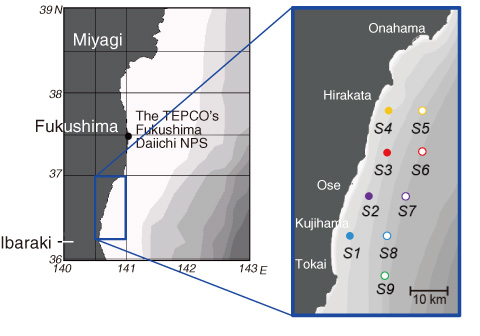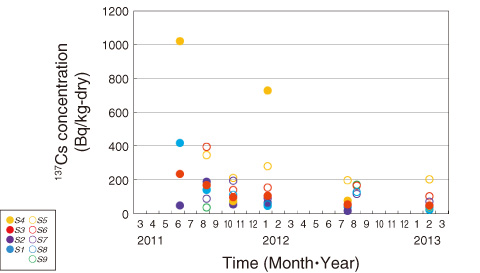
Fig.1-3 Sampling area and stations

Fig.1-4 Time series of concentration of cesium-137 (137Cs) in upper (0~3 cm) layer of seabed sediment
For several months after the accident at the TEPCO’s Fukushima Daiichi NPS (1F), seawater containing accident-derived radiocesium flowed into the coastal regions off northern Ibaraki (Fig.1-3). We therefore set nine stations in the region and have been investigating the temporal variation in the radiocesium concentration in seabed sediment and the factors controlling the concentration by time-series observations.
The observed concentrations of cesium-137 (137Cs) in the upper (0~3 cm) layer of seabed sediment ranged between 16 and 1020 Bq/kg (Fig.1-4). Although the concentrations decreased with time overall, a temporarily high concentration was observed at several stations.
In the shallow regions (less than 50 m of bottom depth), most of the sedimentary radiocesium was adsorbed onto coarse (>75 μm) components, but the concentrations were low. On the other hand, a portion of the radiocesium was adsorbed onto fine-grained sediment, which is easily remobilized by bottom currents, with higher concentrations. From these characteristics, it can be considered that the episodic variation of radiocesium concentration indicates temporal accumulation of fine-grained particles near the seabed associated with the bottom currents.
Depth profiles of 137Cs in the sediment showed that, in the shallow region, a large proportion of the137Cs was accumulated in the deep (>3 cm) layers of the sediment. The higher concentrations of sedimentary radiocesium in the deep layers are attributable to a higher contact probability of dissolved radiocesium with sediment, as well as efficient vertical transport of radiocesium to the deeper layer of sediment via bioturbation.
We also found that most of the radiocesium in the coastal sediment was incorporated into lithogenic (i.e., clay) components, and this incorporation was almost irreversible. These characteristics would be a primary reason for such a slow decrease in the concentrations of sedimentary radiocesium.
The findings of this study will be applied to a simulation model that predicts the distribution of radiocesium on the seafloor.
<Previous: 1 Research and Development Relating to the Accident at the TEPCO’s Fukushima Daiichi NPS | Next: 1-2 >